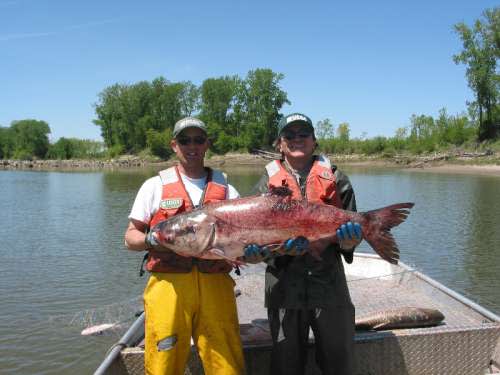USGS Releases Dire New Report on Asian Carp, Great Lakes Governors Mull Solutions
OutdoorHub Reporters 06.27.13

The U.S. Geological Survey (USGS) recently released a report that shows two species of Asian carp, silver and bighead, can spawn in more Great Lakes tributaries than previously expected. It had been thought that the invasive species required river stretches of 62 miles to successfully spawn, but new studies show that carp can release eggs in stretches as short as 16 miles. The USGS conducted the survey to help wildlife agencies prepare for a carp invasion and to localize their efforts on vulnerable rivers.
“If Asian carp spread into the Great Lakes, knowing where to expect them to spawn is a critical step in controlling these invasive species,” said USGS scientist Elizabeth Murphy. “Our study combines the biology of Asian carp early life stages with the physics of rivers to identify potential spawning tributaries, thus giving managers an opportunity to develop targeted control strategies.”
The researchers studied four tributaries for their report: the Milwaukee and St. Joesph Rivers leading to Lake Michigan, and the Maumee and Sandusky Rivers that connect Lake Erie. Scientists have long believed that although adult carp prefer calm waters, carp eggs must be carried along fast currents or else they sink and die. However, it has now been found that the river does not necessarily have to be lengthy for the eggs to survive. Given the right temperatures and water quality characteristics, even short rivers will do. All four tributaries in the study proved sufficient for carp to spawn. This discovery, according to the report, “would expand the number of possible tributaries suitable for Asian carp spawning.”
Scientists also found that dams can be instrumental in creating “settling zones” where the Asian carp eggs collect and sink. Unfortunately, the settling zones caused by dams or natural features in the studied tributaries were not enough to stop the development of young Asian carp.
The Council of Great Lakes Governors met again for the first time since 2005 earlier this month to discuss the future of invasive species in the region, foremost being the siege laid against the lakes by Asian carp. According to Fox News, Illinois Governor Pat Quinn supported a national project to separate the Great Lakes and Mississippi river systems.
“Ultimately, I think we have to separate the basins,” Quinn said at the meeting. “I really feel that is the ultimate solution.”
The comment was met by applause but also raised concerns over jobs and the economic ramifications of such a split. Nearby Indiana’s Governor Mike Pence remains opposed to such a move, saying that it would cost his state thousands of jobs as well as damage commercial infrastructure. Quinn and Pence were previously united in fighting against such a separation in favor of electric barriers in the Chicago area shipping canals. Experts believe that separating the two river systems would have significant consequences for the states’ commercial shipping and travel.
Other states on the council, however, have previously went to court to in an attempt to force the U.S. Army Corps of Engineers to separate the watersheds. Michigan, Wisconsin, Minnesota, Ohio, and Pennsylvania have made multiple attempts to protect their waters from the invasive species, but their latest case was rebuffed by a federal judge in December.
Separating the two waterways can prove to be very expensive, but supporters of the idea say that it will preserve a multi-billion dollar sport and commercial fishing industry. Conservationists are especially delighted to hear of Quinn’s change of heart and so were the states in favor of separation.
“I think it’s great to see people talking about longer-term solutions,” said Michigan Governor Rick Snyder.
Asian carp first were first introduced to United States ecosystems in the 1970s because of their ability to eat undesired vegetation, making them useful for aquaculture purposes. The fish soon escaped into the Mississippi River and began colonizing it. Asian carp compete with native fish and are considered highly destructive. Some carp species are still used for water treatment today, although under a very watchful eye.

